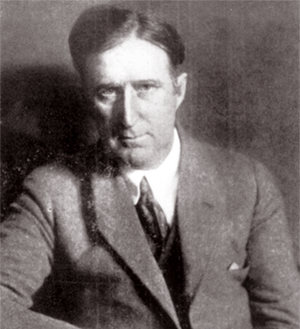Frank Marshall (chess player) facts for kids
Quick facts for kids Frank Marshall |
|
|---|---|

Frank Marshall
|
|
| Full name | Frank James Marshall |
| Country | United States |
| Born | August 10, 1877 New York City |
| Died | November 9, 1944 (aged 67) New Jersey |
Frank James Marshall (born August 10, 1877 – died November 9, 1944) was a very strong American chess player. He was the U.S. Chess Champion for many years, from 1909 to 1936. He was known as one of the best chess players in the world in the early 1900s.
Contents
Frank Marshall's Chess Journey
Marshall was born in New York City. He lived in Montreal, Canada, from age 8 to 19. He started playing chess when he was 10 years old. By the time he was 13, in 1890, he was already one of the top players in Montreal.
In 1904, he won the 1904 Cambridge Springs International Chess Congress. He scored 13 out of 15 points, even beating the World Champion, Emanuel Lasker. He also won the U.S. Congress that year. However, he did not get the national title because the U.S. champion, Harry Nelson Pillsbury, did not play. When Pillsbury died in 1906, Marshall still waited. He finally won the championship in a competition in 1909.
In 1907, Marshall played a match against the World Champion Emanuel Lasker. He lost eight games, won none, and had seven draws. They played their match in several cities across the United States.
In 1909, Marshall played a match against a young Cuban chess player named José Raúl Capablanca. Many people were surprised when Marshall lost. He lost eight games, drew fourteen, and won only one. After this loss, Marshall was not upset with Capablanca. Instead, he saw that Capablanca had amazing talent. Marshall worked hard to help Capablanca get a chance to play against the best players. Marshall insisted that Capablanca be allowed to play in the San Sebastián chess tournament in 1911. This was a very important tournament. Even with protests about his inclusion, Capablanca won the tournament.
Marshall finished fifth at the St. Petersburg 1914 chess tournament in 1914. He was behind World Champion Lasker and future World Champions Capablanca and Alekhine. He was also behind former World Championship challenger Tarrasch. But he was ahead of many other strong players. According to Marshall's autobiography, Tsar Nicholas II gave the title of "Grandmaster" to Marshall and the other top four players. However, some chess historians question if this story is true.
In 1915, Marshall opened the Marshall Chess Club in New York City. This club became very famous. In 1925, Marshall even appeared in a short Soviet film called Chess Fever. He had a small part in the movie along with Capablanca.
In 1920, he won the American Chess Congress.
In 1922, Marshall set a world record. He played 155 games at the same time against different opponents in Montreal, Canada. He won 126 games, drew 21, and lost only 8. This took him just over 7 hours. A week later, he could remember almost every single move from 154 of those 155 games!
In the 1930s, Marshall led the U.S. team to win four gold medals at four Chess Olympiads. These are big international team competitions. During one game, he found his teammates had agreed to three draws. After his own game, he told them that draws do not help win matches.
In 1936, Marshall had been the U.S. champion for 27 years. He decided to give up his title. He wanted the title to be decided by a tournament. The first such tournament was held in New York. The Marshall Chess Club gave the trophy, and Samuel Reshevsky was the first winner.
Marshall's Playing Style
Marshall was best known for his amazing tactical skill. This means he was very good at finding clever moves and tricks. One of his famous tricks was called the "Marshall swindle." This was a way he could turn a game he was losing into a win. People said he was magical at saving games that seemed impossible to win. He was also very good at the endgame, which is the final part of a chess game.
Chess Openings Named After Marshall
Frank Marshall has several chess opening moves named after him. An "opening" is the first few moves of a chess game. Two important opening ideas, called "gambits," are named after him. A gambit is when a player sacrifices a pawn or piece early in the game to gain an advantage.
One is the Marshall Attack in the Ruy Lopez opening. It starts with these moves: 1.e4 e5 2.Nf3 Nc6 3.Bb5 a6 4.Ba4 Nf6 5.0-0 Be7 6.Re1 b5 7.Bb3 0-0 8.c3 d5. Marshall first played this famous opening against José Capablanca in 1918. Even though Capablanca won that game, Marshall's idea became very popular. Black gets good chances to attack with the Marshall Attack. Many top players try to avoid it with "Anti-Marshall" moves.
When Marshall first started playing, he liked attacking openings like the King's Gambit. As Black, he often used the Albin Countergambit. Later, most top players started using different openings and a more positional style. Marshall changed his style too. In his later years, he often used the Caro–Kann Defense and Indian Defenses.
Another important gambit is the Marshall Gambit in the Semi-Slav Defense. It begins 1.d4 d5 2.c4 c6 3.Nc3 e6 4.e4. This opening leads to exciting and unclear games.
There is also the Marshall Defense to the Queen's Gambit (1.d4 d5 2.c4 Nf6). However, this one is not as popular as other defenses.
Famous Quotes
- "The hardest thing in chess is to win a won game."
Notable Games
Marshall's Amazing Queen Move
| h | g | f | e | d | c | b | a | ||
| 1 |

|
1 | |||||||
| 2 | 2 | ||||||||
| 3 | 3 | ||||||||
| 4 | 4 | ||||||||
| 5 | 5 | ||||||||
| 6 | 6 | ||||||||
| 7 | 7 | ||||||||
| 8 | 8 | ||||||||
| h | g | f | e | d | c | b | a | ||
In a famous game against Stepan Levitsky in 1912, Marshall made an amazing move. He offered his queen to be captured in three different ways. No matter how White captured it, it would lead to a quick checkmate or a losing position for White. This is called a sham sacrifice.
- Levitsky vs. Marshall, Breslau 1912: 1.d4 e6 2.e4 d5 3.Nc3 c5 4.Nf3 Nc6 5.exd5 exd5 6.Be2 Nf6 7.0-0 Be7 8.Bg5 0-0 9.dxc5 Be6 10.Nd4 Bxc5 11.Nxe6 fxe6 12.Bg4 Qd6 13.Bh3 Rae8 14.Qd2 Bb4 15.Bxf6 Rxf6 16.Rad1 Qc5 17.Qe2 Bxc3 18.bxc3 Qxc3 19.Rxd5 Nd4 20.Qh5 Ref8 21.Re5 Rh6 22.Qg5 Rxh3 23.Rc5 (see diagram) Qg3!! (This move is considered one of the most brilliant moves ever played. Legend says that after Marshall made this move, the people watching threw gold coins onto the board!) 0–1
Win Over Capablanca
Marshall usually lost to Capablanca. But he was one of the few players who ever beat Capablanca when playing with the black pieces. Capablanca was very hard to beat, especially in the endgame.
- Capablanca vs. Marshall, Havana 1913: 1.e4 e5 2.Nf3 Nf6 3.Nxe5 d6 4.Nf3 Nxe4 5.d4 d5 6.Bd3 Bg4 7.0-0 Nc6 8.c3 Be7 9.Nbd2 Nxd2 10.Bxd2 0-0 11.h3 Bh5 12.Re1 Qd7 13.Bb5 Bd6 14.Ne5 Bxe5 15.Qxh5 Bf6 16.Bf4 Rae8 17.Re3 Rxe3 18.fxe3 a6 19.Ba4 b5 20.Bc2 g6 21.Qf3 Bg7 22.Bb3 Ne7 23.e4 dxe4 24.Qxe4 c6 25.Re1 Nd5 26.Bxd5 cxd5 27.Qe7 Qc8 28.Bd6 h6 29.Rf1 f6 30.Re1 Rd8 31.Bc5 Kh7 32.Qf7 Qf5 33.Be7 Qd7 34.Kf1 Rf8 35.Qe6 Qxe6 36.Rxe6 Re8 37.Re2 Kg8 38.b3 Kf7 39.Bc5 Rxe2 40.Kxe2 f5 41.Kd3 Ke6 42.c4 bxc4+ 43.bxc4 g5 44.g4 f4 45.Bb4 Bf6 46.Bf8 dxc4+ 47.Kxc4 f3 48.d5+ Ke5 49.Kd3 Kf4 50.Bd6+ Be5 51.Bc5 Kg3 52.Ke4 Bf4 53.d6 f2 0–1
See also
 In Spanish: Frank Marshall para niños
In Spanish: Frank Marshall para niños


